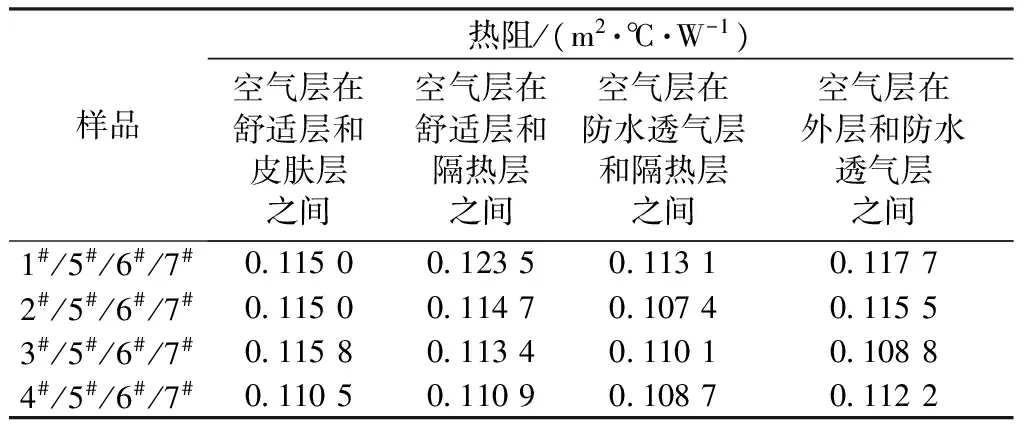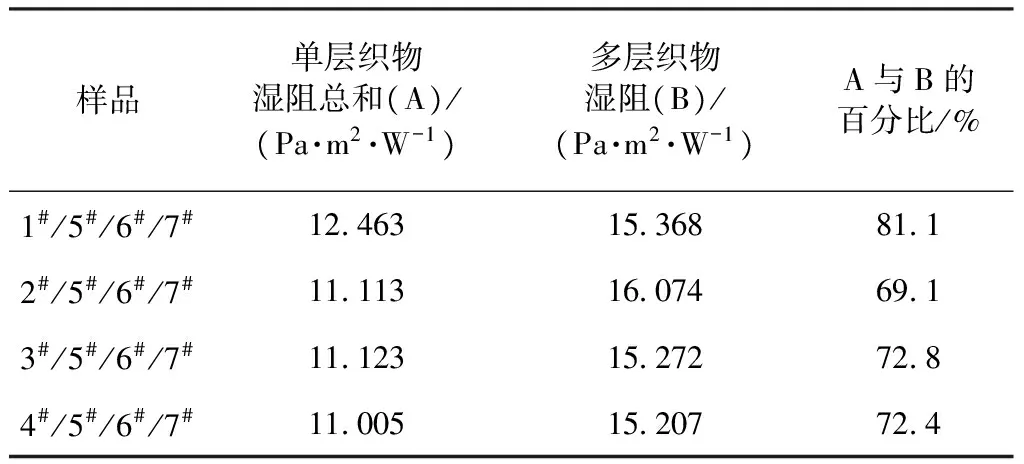消防員防護服面料的熱濕舒適性
李利君, 宋國文, 李 睿, 王麗文, 向春暉
(1. 公安部四川消防研究所, 四川 成都 610036; 2. 愛荷華州立大學 服裝、活動與酒店管理系,埃姆斯 愛荷華 50011)
消防員防護服面料的熱濕舒適性
李利君1, 宋國文2, 李 睿2, 王麗文2, 向春暉2
(1. 公安部四川消防研究所, 四川 成都 610036; 2. 愛荷華州立大學 服裝、活動與酒店管理系,埃姆斯 愛荷華 50011)
為研究消防員防護服面料的舒適性并考察其是否滿足歐美國家相關標準,選取了我國消防員防護服常用的幾種面料,進行單層織物熱阻和濕阻以及多層織物熱阻、濕阻和總熱損失的測試與分析,考察空氣層對多層織物熱阻的影響,并將測試結果與歐美標準的相關要求進行對比。結果表明:在厚度大致相同時,外層面料的密度對熱阻和濕阻影響較大;因為隔熱層材料是非織造布結構,熱阻和濕阻較大;空氣層的位置對多層織物的熱阻值影響不大,但其厚度對多層織物的熱阻影響較大;選取的幾種面料組合,濕阻低于30 Pa·m2/W,總熱損失高于205 W/m2,均滿足歐美國家相關標準要求。
消防員防護服面料; 熱濕舒適性; 熱阻; 空氣層; 濕阻; 總熱損失
消防員滅火防護服是消防員在滅火戰斗時穿著的用于防止高溫和火焰侵害的服裝。消防員滅火防護服通常比較厚重,導致消防員在滅火戰斗時產生熱應激從而削弱其體力及滅火效率[1-3],因此對于消防員滅火防護服熱濕舒適性的研究一直是國際研究的熱點問題[4-6]。目前我國對于消防員滅火防護服的研究大部分集中在提高其防護性能的領域,而對于防護服舒適性的研究卻很少[7-9]。
通常用來表征服裝生理舒適性的指標有:熱阻、濕阻和總熱損失[10]。熱阻和濕阻是防護服生理舒適性的2個關鍵因素。熱阻指服裝材料對穿著者的生理熱從身體傳遞到周圍環境的阻力;濕阻指服裝材料對穿著者的汗蒸汽從身體傳遞到周圍環境的阻力[11];總熱損失是指通過服裝材料傳遞的干熱和蒸發熱量的總和。
美國建筑物滅火防護標準NFPA 1971—2013《建筑火災及近火作戰防護裝備標準》中要求防護服的總熱損失不低于205 W/m2,歐洲標準EN469—2014《消防人員的防護服裝 消防防護服裝的要求和試驗方法》中規定消防員防護服的濕阻不超過30 Pa·m2/W,而我國消防員防護服相關標準中未對服裝整體的舒適性提出要求。
本文選取我國消防員滅火防護服裝常用的幾種面料,進行熱阻、濕阻和總熱損失的測試與分析,并將測試結果與美國標準NFPA 1971—2013及歐洲標準EN469—2014的相關要求進行比較。
1 實驗部分
1.1 測試樣品
實驗所用的面料厚度大致相同,其組成及面密度如表1所示。

表1 實驗所用的面料Tab.1 Samples used in test
注:PTFE為聚四氟乙烯。
1.2 測試儀器與方法
測試采用Measurement Technology Northwest公司的出汗熱板,測試條件為:溫度25 ℃,濕度65.0%,風速1.00 m/s。
根據NFPA1971—2013規定的ASTM F 1868—2002《采用出汗熱板測定服裝材料的熱阻和濕阻的標準試驗方法》,測試熱阻和濕阻。
2 結果與討論
2.1 熱阻分析
對單層面料織物的熱阻(Rcf)進行了測試,結果如表2所示。從表中可看出:當厚度基本相同時,對于外層材料來說,面密度越大,熱阻越大;因為隔熱層材料是非織造布結構,所以盡管面密度最小,熱阻也相對較大。

表2 單層織物的熱阻Tab.2 Rcf of single-layer fabrics
對多層面料織物的熱阻進行了測試,其中1#/5#/6#/7#表示按照外層1#、防水透氣層5#、隔熱層6#和舒適層7#的順序將這4層面料疊放在一起(下同),測試多層面料總的熱阻值。該多層面料即構成消防員滅火防護服的基本面料組合。測試結果見表3。

表3 多層織物的熱阻Tab.3 Rcf of multi-layer fabrics
從表3可發現,僅外層面料不同,其他幾層面料都相同的情況下,多層織物的熱阻值差別不大。
將單層織物的熱阻值加和,并與多層織物的熱阻值相比較,結果見表4。從表可發現,單層織物的熱阻加和值與多層織物的總熱阻值相比,僅占多層織物總熱阻值的60%~70%。這是因為在多層織物之間存在空氣層,多層織物的總熱阻包括織物的熱阻和織物之間空氣層的熱阻2部分,其中空氣層的熱阻值為多層織物熱阻值的30%~40%。

表4 單層織物熱阻總和與多層織物熱阻值的比較Tab.4 Comparison between total Rcf of single-layer fabrics and Ref of multi-layer fabrics
為進一步研究空氣層對多層織物熱阻值的影響,在多層織物之間增加厚度為3 mm的空氣層,考察了空氣層的位置(位于外層、防水透氣層、隔熱層、舒適層及人體皮膚層之間)對多層織物熱阻值的影響,結果如表5所示。從表可看出,空氣層位于多層織物不同層之間時,熱阻值基本變化不大,即空氣層位置對多層織物的熱阻值影響不大。對比表5和表3可知,增加厚度為3 mm的空氣層后,多層織物的熱阻值增加約10%。由此可見,在消防服設計中,增加空氣層的厚度,對熱阻影響較大。

表5 空氣層對多層織物熱阻的影響Tab.5 Influence of air gap on Rcf of multi-layer fabrics
2.2 濕阻分析
德國海恩斯坦研究院研究了不同環境條件和活動水平情況下雨衣織物和人的舒適感之間的關系,結果見表6[12]。

表6 織物濕阻和服裝舒適感之間的關系Tab.6 Relationship between intrinsic fabric evaporative resistances and clothing comfort
單層織物的濕阻值(Ref)見表7。從表可看出:當厚度大致相同時,對于外層面料來說,密度越大則濕阻越大;因為隔熱層材料是非織造布結構,所以盡管面密度最小,但是濕阻也較大。

表7 單層織物的濕阻Tab.7 Ref of single-layer fabrics
多層織物的濕阻見表8。從表可發現,本文選取的幾種面料組合,濕阻值在15~16 Pa·m2/W之間,滿足歐洲標準EN469—2014規定的濕阻不超過30 Pa·m2/W的要求。另外根據表4,對照德國海恩斯坦研究院對于織物舒適性的研究結果,本文選取的幾種面料組合的濕阻屬于基本舒適。

表8 多層織物的濕阻Tab.8 Ref of multi-layer fabrics
注:EN469—2014標準要求的濕阻≤30 (Pa·m2)/W。
單層織物的濕阻加和值與多層織物的濕阻值比較見表9。從表可發現,單層織物的濕阻加和值與多層織物的總濕阻值相比,僅占多層織物總濕阻值的70%,這同樣是因為在多層織物之間存在空氣層,多層織物的總濕阻包括織物的濕阻和織物之間空氣層的濕阻2部分,其中空氣層的濕阻值為多層織物濕阻值的20%~30%。

表9 單層織物濕阻總和與多層織物濕阻的比較Tab.9 Comparison between total Ref of single-layer fabrics and Ref of multi-layer fabrics
2.3 總熱損失
根據多層織物的熱阻和濕阻,計算了多層織物的總熱損失,計算公式如下。
式中:Qt為總熱損失;Rcf為樣品的平均內在熱阻;Ref為樣品的平均表觀內在濕阻。
將計算結果與NFPA1971—2013的標準要求進行了比較,結果見表10。可看出,本文選取的幾種面料組合的總熱損失均滿足NFPA1971—2007的標準要求。

表10 多層織物的總熱損失Tab.10 Total heat loss of multi-layer fabrics
注:裸盤指出汗熱板中不放置測試樣品;樣品指實驗中所用的防護服織物樣品。
3 結 論
本文選取我國消防員滅火防護服裝常用的幾種面料,對其進行了熱阻、濕阻和總熱損失的測試與分析,并將測試結果與美國標準NFPA 1971—2013及歐洲標準EN469—2014的相關要求進行比較,得出以下結論。
1) 當厚度基本相同時,對于外層面料,面密度越大,則熱阻和濕阻越大;對于隔熱層材料,盡管面密度較小,但因為是非織造布結構,熱阻和濕阻較大。
2) 空氣層的位置對多層織物的熱阻值影響不大。增加厚度為3 mm的空氣層,多層織物的熱阻值增加10%左右,因此空氣層的厚度對于消防服的熱阻影響較大。
3) 本文選取的幾種面料組合,濕阻滿足EN469—2014的標準要求,總熱損失滿足NFPA 1971—2013標準要求。
FZXB
[1] 苗勇, 李俊. 減少熱蓄積的消防服開發及其性能評價[J]. 紡織學報, 2016, 37(1):111-115. MIAO Yong, LI Jun. Development and evaluation of firefighter′s clothing capable of enhancing heat dissipa-tion[J]. Journal of Textile Research, 2016, 37(1): 111-115.
[2] ROSSI R. Fire fighting and its influence on the body[J]. Ergonomics, 2003, 46(10):1017-1033.
[3] SMITH D L, PETRUZZELLO S J, KRAMER J M, et al. The effects of different thermal environments on the physiological and psychological responses of firefighters to a training drill[J]. Ergonomics, 1997, 40(4): 500-510.
[4] MCLELLAN T M, SELKIRK G A. Heat stress while wearing long pants or shorts under firefighting protective clothing[J]. Ergonomics, 2004,47(1): 75-90.
[5] HOLMER I. Protective clothing in hot environ-ments[J]. Industry Health, 2006,44(3): 404-413.
[6] HE Jiazhen, LI Jun, KIM Eunae. Assessment of the heat and moisture transfer in a multilayer protective fabric system under various ambient conditions[J]. Textile Research Journal, 2015, 85(3): 227-237.
[7] 羅琦, 徐盛, 金朝霞, 等. 滅火防護服熱濕舒適性探討[J]. 勞動保護, 2012(5):88-90. LUO Qi, XU Sheng, JIN Zhaoxia, et al. Research on heat-moisture comfort of firefighter′s protective clothing[J]. Labour Protection, 2012(5):88-90.
[8] 漆政昆, 張和平, 黃冬梅, 等. 消防服用織物材料熱濕舒適性綜合評價[J]. 中國安全科學學報, 2012, 22(4): 132-138. QI Zhengkun, ZHANG Heping, HUANG Dongmei, et al. Comprehensive evaluation of thermal and moisture comfortableness of fabric for firefighter protective clothing[J]. China Safety Science Journal, 2012, 22(4):132-138.
[9] 宗藝晶, 李俊. 消防服熱濕舒適性客觀測評表征指標的比較[J]. 東華大學學報(自然科學版), 2013, 39(6):748-753. ZONG Yijing, LI Jun. Comparison of objective evaluation indices on thermal-moisture comfort of firefighting protective clothing[J]. Journal of Donghua University (Natural Science), 2013, 39(6):748-753.
[10] 傅吉全, 陳天文, 李秀艷. 織物熱濕傳遞性能及服裝熱濕舒適性評價的研究進展[J].北京服裝學院學報, 2005, 25(2):66-72. FU Jiquan, CHEN Tianwen, LI Xiuyan. Progress of study on fabric heat-moisture transport properties and clothing heat-moisture comfort evaluation[J]. Journal of Beijing Institute of Clothing, 2005, 25(2):66-72.
[11] CARAVELLO V. Total evaporative resistance of selected clothing ensembles[D]. Tampa, FL: University of South Florida, 2004: 10-15.
[12] BARTELS V T, UMBACH K H. Development and evaluation of protective textile products with multiple function[C]//Textile International Forum and Exhibition. Taipei, Taiwan:[s.n.], 2001:14-16.
Heat-moisture comfort of fire-fighter′s protective clothing materials
LI Lijun1, SONG Guowen2, LI Rui2, WANG Liwen2, XIANG Chunhui2
(1.SichuanFireResearchInstituteofMinistryofPublicSecurity,Chengdu,Sichuan610036,China;2.DepartmentofApparel,EventsandHospitalityManagement,IowaStateUniversity,Ames,Iowa50011,USA)
In order to study heat-moisture comfort of fire-fighter′s protective clothing and investigate whether it meets the requirements of European and American standards, thermal resistance, evaporative resistance and total heat loss of various fire-fighter′s protective clothing materials were tested and analyzed. Furthermore, the influence of air gap on the thermal resistance of multilayer fabrics was also studied. The results were compared with requirements of European and American standards. It is found that when thickness of the fabrics is substantially the same, density affects greatly on thermal resistance and evaporative resistance of outer shell materials. For thermal barrier material, its thermal resistance and evaporative resistance are much higher because of its non-woven structure. Location of air gap has little effect on the thermal resistance of multilayer fabrics. However, the thickness of air gap may have great effect on the thermal resistance of fire-fighters′ protective clothing. The evaporative resistance of the multilayer fabrics is lower than 30 Pa·m2/W and the total heat loss thereof is higher than 205 W/m2, which meets the requirements of European and American standards.
fire-fighter′s protective clothing material; heat-moisture comfort; thermal resistance; air gap; evaporative resistance; total heat loss
2016-04-05
2016-10-12
國家留學基金管理委員會及國家重點研發計劃項目(2016YFC0800605)
李利君(1980—),女,副研究員,博士。主要研究方向為防火阻燃材料及消防員防護服裝。E-mail: lljscf@163.com。
10.13475/j.fzxb.20160400604
TS 941.17
A

